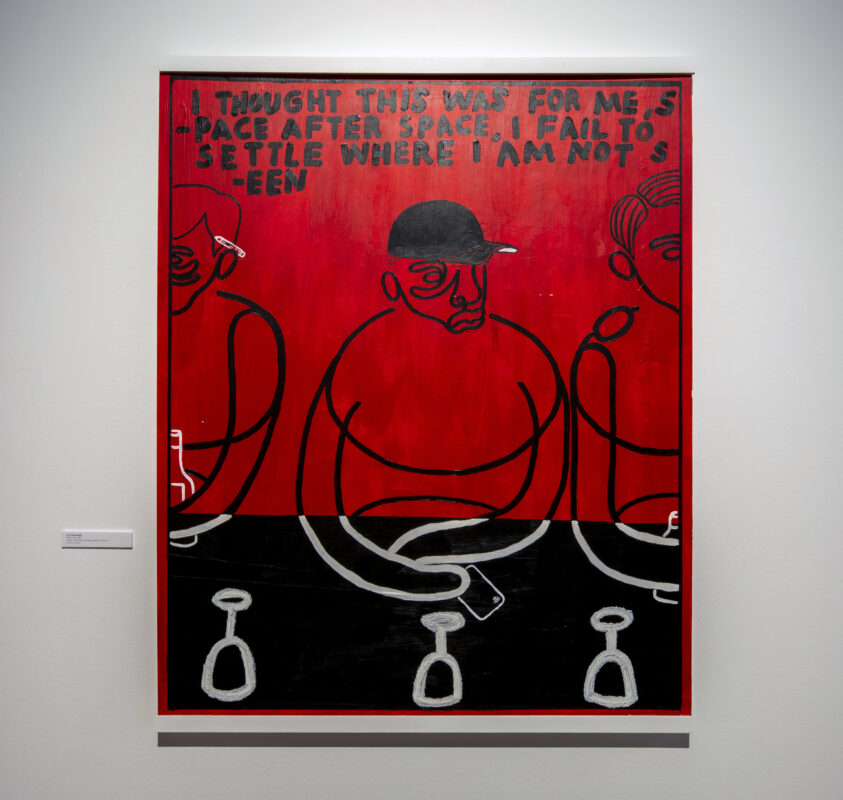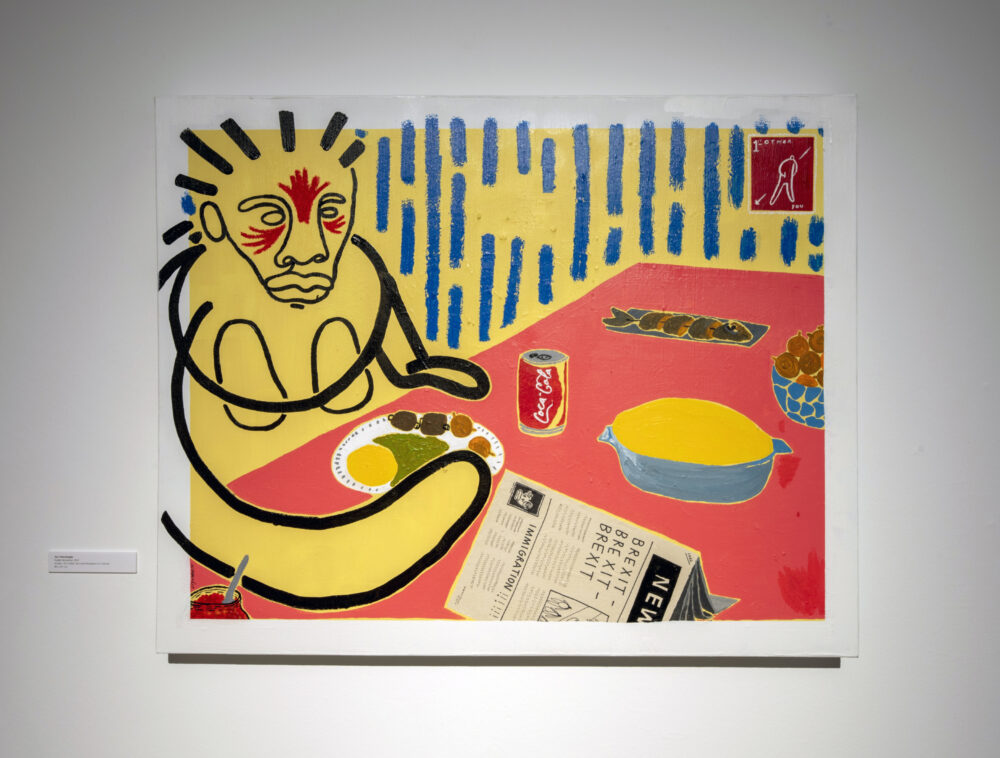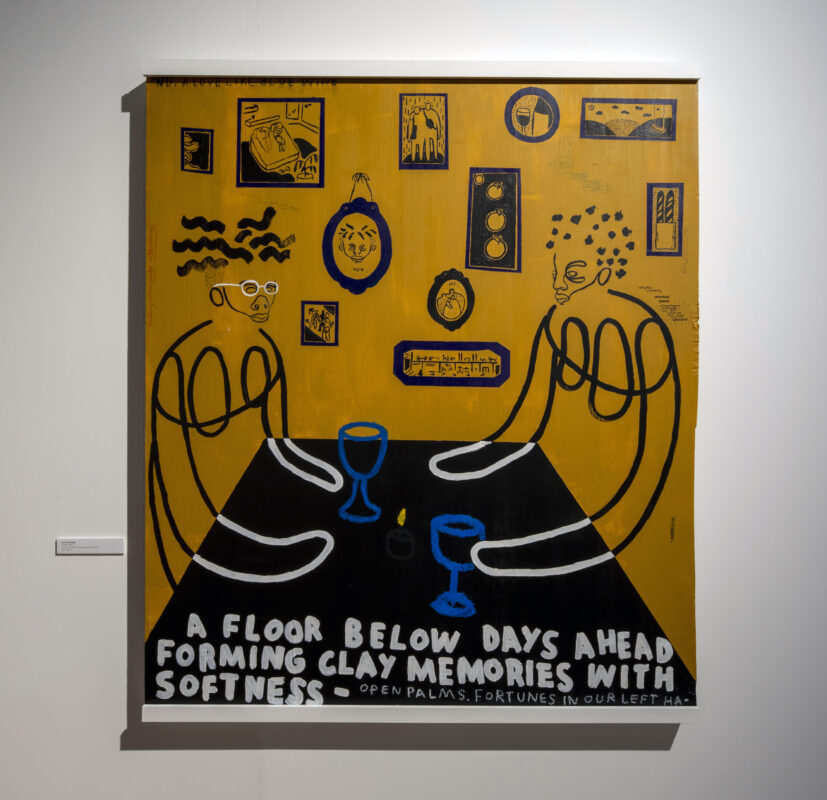BOC: The colour blue is a recurring palette within recent work. Has this any specific or even spiritual significance for you?
JY: It has so much a variety of emotions behind it, it can be sadness, it can be warmth. When I think of blue I think of the sea, love, club lights, love and loss all at the same time. I’m drawn to its complexity and simplicity as primary colour at the same time. It just feels right for the moment.
BOC: Can you explain the title, Blue Glass Fortunes, and what the motif of the drinking vessel – sometimes a wine glass, other times more like to a ceremonial goblet – may represent?
JY: The painting Blue Glass Fortunes, was the first in this series and depicts a dream that I had. The thing that stood out the most from this dream was the blue goblets which were lighting up the room as if they held candles in them. That visual of these glasses just stuck with me and this interest in the shape and what this could mean has been ongoing.
Going to church as a kid, I noticed that within Bible stories, dreams were looked to for revelations of the future and messages from God. They were seen as more than just stories. I don’t quite know what the glasses have come to mean, if anything – it’s something you only realise after time has gone, like when you remember what an old fortune cookie once said, or what a tarot reading predicted, the answer usually becomes clear after time. It’s definitely a journey.

Joy Yamusangie, Black Cap, 2020, Acrylic, oil, pastel and mixed media on wood. Photo credit: Lee Baxter
BOC: Who do you feel are the subjects of your work, and what emotions are they experiencing as we encounter them?
JY: I draw from my own experiences, and with this series it is a mixture of dreams, memories and hopes so the figures within the works are usually interpretations of myself. Some things change consistently from piece to piece like hair but certain markings (a line under the lip, and one on the lip) are indicators that I use to signal that this is of me. Self portraits started off as drawing exercises for me but over time came to be a central part of my practice. Like taking a selfie it is a way of documenting the present moment.
Black Cap and Underneath the Black Sky have a similar feeling to them and it’s definitely one of invisibility and yet visibility. In Underneath the Black Sky, the space around the isolated figure shows that there is an awareness of my presence there which is why figures of people are drawn sitting away yet the same space also shows an invisibility, it’s really a wider comment on Blackness and how society can willingly consume and exploit Black culture (a closer look at the items in each person’s hands) and yet react to the physical presence of Black people negatively. The setting for this piece is the tube, it’s an overhead angle of a train carriage.
BOC: In the pieces selected for the show, there is a suggestion of two primary locations – outside (public) space, and inside (domestic) space. Does either hold any particular associations for you?
JY: I wouldn’t say that these hold strong associations within my work. I would say there’s more of a distinction between day and night within my work, with night being linked to nightlife and community and safety and daytime being linked to invisibility in working and public spaces in terms of Blackness and gender.

Joy Yamusangie, Phantasm – The American in the Middle, 2019, Oil, acrylic, oil pastel on heavyweight wood. Photo credit: Lee Baxter
BOC: What role does food and drink play? We’re never too far from refreshments in these pieces!
JY: It plays a large part in the artworks and also for so many of us subconsciously. To celebrate we have food or a drink, when there’s bad news we come together for a drink, when we get a new job, catch up etc. food and drink is often part of the scene in British culture and so many other cultures. So by having food, drinks and wine as part of the setting it feels like the scene is completed.

Joy Yamusangie, English Breakfast, 2019, Acrylic, oil, pastel, pen and newsprint on canvas. Photo credit: Lee Baxter
BOC: There’s a languid, reflective quality to Jesus Christ Est Reel, English Breakfast, Scooter and Looking Back, Looking Blue, as if the viewer has interrupted a moment of contemplation. They have a suggestion of between-states, a pause or interruption in time. Is this a fair interpretation?
JY: I’ve never quite thought about the viewer’s place in the moment, but it does feel like a fair interpretation as the moment that is captured in the painting is often still, a quietness with no conversation, just reflection. It’s a lot more noticeable in pieces like Underneath The Black Sky, which depicts a train carriage, something that’s constantly in movement and never still but the artwork is of a paused moment, a stillness.
BOC: I’d love to know a little more about your journey as an artist. I’ve read that you studied, but didn’t especially enjoy the experience. I think audiences would still be interested to know the steps that you took, but especially that it wasn’t necessarily the right fit for you (very few people every share this quite common fact!)
JY: University was quite a cultural shock for me, though it allowed me to see the flexibility within Illustration encouraging me to experiment. It came with more cons than pros, as contrary to how the university presented itself on the opening day, I quickly learnt the harsh reality of living in Portsmouth, that is racism was highly prominent and as a result I experienced daily hostility and racism which was very disappointing.

Joy Yamusangie, Scooter, 2019, Acrylic, oil and pen on heavyweight wood. Photo credit: Lee Baxter
Post university, I was unable to find any work and therefore I wasn’t in a position to get a studio or work as an artist full time. I ended up getting a telephone researcher and then later taking on a retail job for three years. I started drawing again on my breaks and started an Instagram documenting all of the little drawings, scribbles etc.
After a few years I was able to afford an art studio in East London and that really encouraged me to dedicate more time to my artwork now. I took part in ‘diy’ pop up group shows with other local artists, and became more engaged with the independent Black arts scene. Eventually I had my first solo show at 198 Gallery in Brixton.
BOC: Did study open up any benefits for you that you might not have had access to otherwise, even if only artists you didn’t know about, the influence of peers, or access to materials and means of production?
JY: Yes, it allowed me to access materials and processes that I wouldn’t have the finance or resources to even consider. I explored a range of print processes, my favourite being screen printing which is a medium that I’ve come back to post studying.
BOC: Who or what are your primary influences?
JY: Henri Matisse, particularly his paper cut outs. The later works of Fernand Léger, his painting The Man in the Blue Hat has been one of my favourite paintings for many years.
BOC: To what extent does childhood and memory still impinge upon your present moment and creative practice?
JY: I am quite a reflective person and also an unintentionally forgetful person. I can always seem to remember things much more clearly when there’s a photo but for the memories where there were no photos taken, drawing these stories is a way of documenting the moment and preserving the memory in full.

Joy Yamusangie, Looking Back, Looking Blue, 2019, Acrylic, oil and pen on canvas. Photo credit: Lee Baxter
BOC: Do you feel any external pressure to be a mouthpiece for anyone other than your own lived experience?
JY: It plays a part of my work, but it isn’t all that my work is. It’s impossible for me to separate these socio-political issues or my identity from my art, when these things directly impact my life and my life is the basis of my work. But as it is so personal, my work can only speak of my own experience, though I’ve observed that the pressure to have work that speaks for a whole community is often one that is only applied to Black artists.
BOC: I’m interested in your experience as a visitor and audience member to view the art of others, be it in a gallery, theatre, concert or cinema. What do you enjoy? What do you dislike?
JY: I mostly go to galleries, I like being able to experience the art at my own pace, to chat about the work with my friends and have the space to roam. I like exhibitions by painters, shows that exhibit archived materials and independent shows (as in ones that are not organized by institutions but by local artists and collectives).
BOC: I spend a lot of time trying to convince those who haven’t studied art, haven’t had work purchased, haven’t yet had an exhibition and don’t belong to any formal classification of practice that they are, indeed, an artist. What would you say to someone who feels this way?
JY: There’s not one sole way to be an artist, there are really so many different ways into the arts, someone else’s journey may not work at all for you. I called myself an artist way before I had a degree, with no exhibition history. For me, it perfectly described my practice. If it’s what you do, then that’s what you do.